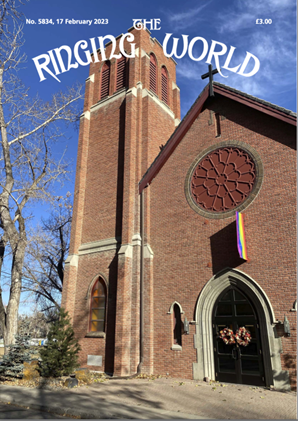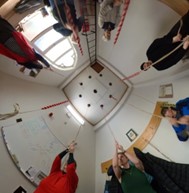by Yolande Hasselo
When you hear bells ringing, you know you have found a community. The familiar sound of eight English change ringing bells connects Elbow Park with surrounding communities throughout history, across Canada, and far beyond.

How is This Distinct Chorus of Bells Achieved?
It is done with wooden wheels and heavy ropes, all powered by human muscle. It is a moving example of pre-modern technology once shared by the great sailing ships or the cathedral architects with their wooden scaffolding, their ropes, and pulleys. Yet here they are in Calgary, still in use. The bells provide a soundtrack to historic moments, a call-out for celebrations and they toll in empathy for grief. Singing their musical messages since 1955, one of the historical highlights includes ringing upon Queen Elizabeth’s death on September 8, 2022.
Change Ringing Bells
Change ringing is a traditional art which has its origins in the 16th century, and with over 6,100 bell towers still in use today, the composer Handel rightly described England as the ringing isle. Change ringing bells can be found all over the world, and the bells in Elbow Park are just one of seven change ringing towers in Canada.
Laid on the ground, the massive tower bells would seem cold, immovable, and lifeless. But that is not how people in the Middle Ages spoke of bells. And under their influence, it is not how we speak of them now. We still say that bells have a lip, or a mouth. The clapper that creates the sound is commonly called the tongue. Each of the eight bells in Elbow Park has an inscription on them, which is “spoken” when the bell sounds. I particularly bell number five’s inscription:
“Here the prairies touch the mountains
Here the Bow and Elbow meet
For such beauty, Lord, we thank thee
Sung in bell notes clear and sweet”

Bellringers have developed their own unique form of music, following special patterns to make the bells sound in a different order each time they swing. These rows of changing sequences remind me of knitting patterns. A special challenge is to ring for several hours without ever repeating a sequence already rung. It would take over 18 hours non-stop to work through all the possibilities on eight bells!

Why Practice Change Ringing?
Bellringing is a group activity that combines physical coordination and mental alertness to produce the unique sounds of change ringing. This combination ensures a lifetime’s enjoyment.
Many people ring as a contribution to community life; others enjoy learning a traditional skill which has been passed down for centuries.
Ringers everywhere enjoy the social aspects of their hobby, meeting regularly to ring bells for various occasions, including a weekly practice session.
Becoming a bellringer is a gateway to the world-wide community of ringers and a life-long learning experience.
Could I Become a Bellringer?
Most likely, yes.
Bellringing does not require great physical strength, nor do you need any knowledge of music or mathematics. It’s all about rhythm, memory, and concentration.
With some intensive practice at the outset, you will quickly be able to control bells weighing between 350 to 950 pounds. Change ringing comes next, with its intriguing mix of quick-thinking, listening, and fine-tuning of the physical skills. The fun starts right from the beginning.

Click here to the Erlton Community News home page for the latest Erlton community updates.









